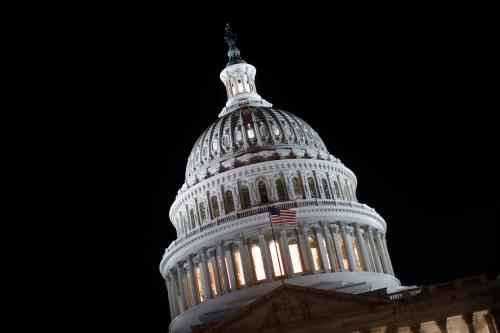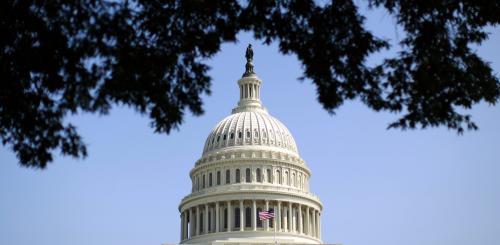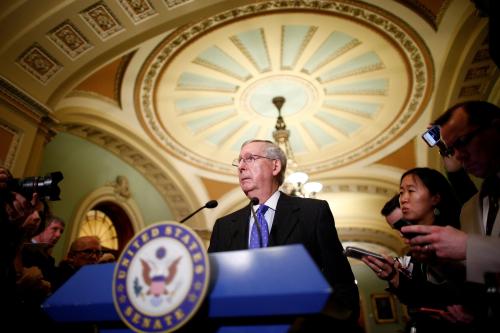Despite promises to “let a thousand flowers bloom,” last week the Senate was anything but a fruitful garden. After two days of fits-and-starts efforts to begin floor debate, senators cast four back-to-back votes on various immigration proposals. The process was structured such that all four would need at least 60 votes to pass. None cleared that threshold, leaving tens of thousands of DACA recipients vulnerable to deportation in the months to come.
This kind of dysfunction is nothing new to Senate watchers. In a new book entitled Broken, Ira Shapiro lays much of the blame for the Senate’s current state at the feet of those who lead the chamber. And while there are certainly choices those leaders have made about how to run the Senate and how to use Senate rules and procedure that have contributed to the environment in which we currently find ourselves, it’s equally as important to consider the environment that those leaders have found themselves in.
First of all, since the early 1980s, bipartisan compromise has become harder to achieve in the Senate, in part because of the disappearance of moderate Republicans and conservative Democrats. According to political scientists’ workhorse measure for capturing House members’ and Senators’ ideologies, the distance between the most conservative Democrat and the most liberal Republican in the Senate has grown significantly. To the extent that major legislation still gets done, it tends to happen on a bipartisan basis, but it is harder to build those coalitions in a time of polarized parties. Senate leaders, then, are heading into a legislative environment where ideological positions make it more difficult to work collaboratively, regardless of the tactics they use.
The electoral fate of individual senators has also become more closely tied to national political forces, decreasing their individual incentives to work with members of the opposite party. In 2016, for example, no state with a Senate election chose a senator of one party while giving its electoral votes to the presidential candidate of the opposite party—the first time this occurred since the advent of popular election of senators in early 20th century. Voters, in other words, are not splitting their tickets at the same rate they once were, which means that senators have less of an incentive to try to formulate the kind of independent brand that would involve working across party lines.
Perhaps the biggest electoral difference, however, is the increase in partisan competition for control of the chambers of Congress since about 1980. As political scientist Frances Lee has documented, the period between the early 1950s and the early 1980s was dominated in Congress by Democrats—the party controlled both chambers, and Republicans in one Congress did not have a reasonable expectation that they would take control after the next election (in the following Congress). Since about 1980, however, majority control of the Senate has been more or less up for grabs each election cycle. Because of this heightened competition, both parties in the Senate have an incentive to engage in more messaging activities that help them win elections over messaging that helps them legislate. This is especially true for minority parties, who have little incentive to make their majority party opponents look like capable legislators.
This emphasis on messaging and the potential of shifts in party control also means that there can be increased value in putting bills on the floor that are intended to fail. A majority party may think it worthwhile to write a piece of legislation that it knows will not become law in order to signal to its voters and interest group allies what it would do if it had more power after the following election. Recall, for example, when Republicans sent a veto-bait Obamacare repeal bill to President Obama’s desk in 2016; they knew that it would get vetoed, but they wanted to be able to keep the issue active as a campaign topic during the 2016 election.
Beyond these changing electoral circumstances, we have also seen growing incentives from outside the chamber for senators inside the chamber to exploit all of their individual procedural rights to try to achieve political goals. My Brookings colleague, Sarah Binder, and her co-author Steve Smith made this argument in a book on the Senate filibuster from the late 1990s, suggesting that once interest group allies and other external audiences began rewarding senators for using obstructive tactics in the chamber, senators’ incentives to engage these behaviors increased. Take, for example, Senator Ted Cruz’s decision to engineer a government shutdown in 2013 over the Affordable Care Act. That use of his procedural rights helped build his national reputation. When senators believe there is political value in using all of the available procedural tools, they are likely to do so at the expense of bipartisan legislative work.
These broader political circumstances have also made it more difficult for senators of both parties to unite as a counter-balance to executive power. In the early 1970s, we saw several high-profile pieces of legislation—like the Congressional Budget Act and the measure creating the Senate Intelligence Committee to oversee certain executive branch activities—pass with large, bipartisan majorities. This cooperation occurred, in part, because senators from both parties saw a reason to work together to increase the legislative branch’s power at the expense of the executive branch. As the president has become an increasingly polarizing figure in American politics, however, it can be more difficult to build support for an issue on institutional grounds. Even matters that might be ripe cross-partisan coalitions can be harder to address if the president is too closely identified with them. In 2015, for example, when President Obama was lobbying Congress on fast-track trade legislation, Republican congressional aides asked the White House to stop requesting that Congress “give” him the authority to negotiate trade agreements. They did not want to be seen as “giving” a Democratic president any special powers.
In an honest account of how the Senate got to where it is today, Senate leaders are far from blameless. But to potentially fix the chamber moving forward, we need to ask hard questions about whether individual senators really want to regain more power over the process, and if they got it, whether they would actually use it to do the hard work of legislating. The broader political context in which they find themselves suggests the answers to those questions may be no.
The Brookings Institution is committed to quality, independence, and impact.
We are supported by a diverse array of funders. In line with our values and policies, each Brookings publication represents the sole views of its author(s).











Commentary
Why is the Senate broken?
February 21, 2018